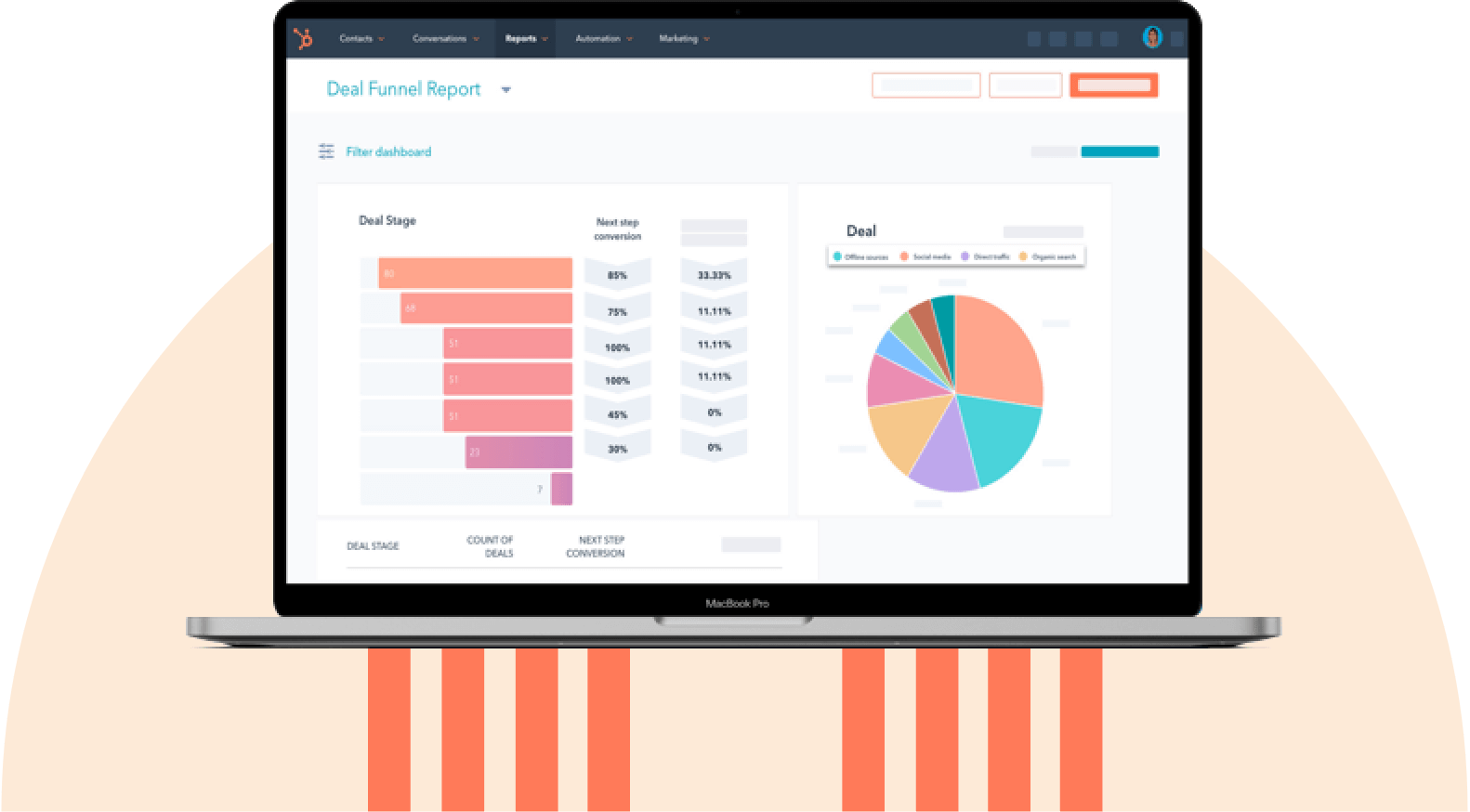Effective sales activity management helps you make data-driven adjustments to your sales strategy, set clear goals for your team, and directly influence revenue and business outcomes.
In this post, I’ll go over tips for how to manage sales activity (with insight from experts) and recommend software that can help along the way.
Table of Contents
- What is sales activity management?
- Reasons to Track Sales Activity
- 3 Steps to Implementing Sales Activity Management
- Top 10 Sales Tracking Software
While your reps focus on making calls, scheduling demos, and talking to stakeholders, you’re responsible for determining which activities actually move the needle. Effective sales activity management uses key sales metrics to guide the creation of repeatable processes and clear goals that enable you to predict and improve revenue outcomes.
Nikita Sherbina, Co-Founder & CEO of AIScreen, emphasizes that it’s not just about tracking numbers: “The key to turning [sales] metrics into actionable strategies is to focus on the quality of activity, not just the quantity.”
Sherbina says that this process worked for him when he identified a rep who was putting in the work but not closing many deals. He dug into their process, found areas for improvement, and set up a coaching plan: “The shift from just tracking activity to analyzing the effectiveness of that activity made a huge difference. Since implementing this, we’ve seen a 20% increase in conversion rates across the team.”
Reasons to Track Sales Activity
1. Increased Revenue
Sales activities directly impact your bottom line (revenue). As a sales manager, identifying key daily behaviors, tracking them, and helping reps optimize their processes helps you create a framework for consistent revenue growth.
When your reps know exactly what activities drive success and how they can master them, they’ll close more deals.
Even minor, targeted adjustments based on activity can yield revenue gains: “I once worked with a team struggling to hit quotas. By analyzing their call-to-close ratio, we identified that increasing follow-ups by just 15% lead to a 20% improvement in conversions” says Brandon Leibowitz, Owner of SEO Optimizers.
2. Streamlined Processes
Sales activity management helps you eliminate wasted effort and focus your team on what works. You can pinpoint which activities consistently lead to wins, create clear and repeatable processes that scale, and streamline best practices across your team.
Harmanjit Singh, Founder and CEO of Website Design Brampton, says that looking at top performers is a great way to determine what should be part of your streamlined processes. He calls this creating success patterns: “We discovered our top closers weren‘t necessarily making more calls, but were spending more time researching prospects before reaching out, resulting in more meaningful conversations. We turned this insight into a pre-call research template that boosted our team’s conversion rates by 30%.”
Singh adds, “The key is turning [sales] metrics into stories that reveal what works, then systematizing those successful approaches.”
3. Boost Team Morale
Managing sales activity also boosts team morale and helps reps feel empowered by providing clear direction and allowing them to focus on activities they can directly control.
Joseph Passalacqua, Owner & CEO of Maid Sailors, recommends “[Breaking] large quotas into smaller daily achievements to maintain forward motion.” You empower reps by connecting their daily work to meaningful outcomes, and day-to-day morale becomes more manageable when reps know exactly what to focus on for success. Plus, they get an additional motivational boost as deals start flowing in.
Activity-based contests can even create a sense of healthy competition to energize your team while driving behaviors that lead to sales.
4. Increased Visibility and Reporting
Sales activity management magnifies visibility into overall team (and individual) performance, provides early warning signs when metrics lag, and clearly indicates where coaching is needed.
For example, if you missed a revenue target, activity management would help you identify where the issue arose and implement targeted corrections rather than just a general “we need to do better!” pep talk.
It also gives you cleaner reporting to show higher-ups precisely how your efforts translate to revenue growth.
In other words, getting the business results you want hinges on managing the activities that precede them. Now we’ll go over an easily replicable process for sales activity management.
3 Steps to Implementing Sales Activity Management
1. Determine key selling activities.
To determine your key selling activities, I recommend you:
- Lay out the structure of your sales organization. Define the sales activities that lead to won deals and note each selling role and where it fits into the sales process. For example, do your sales development reps generate leads and then distribute those leads to account executives? Or are your field sales reps handling deals from start to finish with their assigned territories?
- Define the critical activities for each role. For SDRs, you might have them focused on meetings scheduled and sales accepted opportunities. On the other hand, for a field sales rep, those activities might be opportunities discovered, VP-level conversations, face-to-face meetings, and proposals sent.
- Gather input from your team. Interview your sales managers and reps for their perspectives on key activities. You can ask top performers about their daily activities to uncover what’s helping them succeed.
Use all of the information you’ve gathered to analyze best practices, define the core sales activities that drive the most success, develop techniques and strategies for mastering them, and share that information with your team.
Ryan Moore, Founder & CEO of Pheasant Energy, emphasizes the importance of looking beyond sheer volume when determining key activities. “In the energy sector, where sales cycles are long, and deals are complex, focusing solely on activity volume like call counts is shortsighted. Instead, I've learned that metrics like qualified meetings, site visits, and offers made are the true leading indicators that eventually drive revenue.”
His tip applies, regardless of industry: identify the meaningful activities that genuinely move deals forward, and emphasize their importance.
2. Reverse-engineer your sales process.
“Sales activity metrics are only valuable if they translate into smarter actions. The real differentiator isn’t just tracking calls or deals closed…Sales is a numbers game, but smart sales is about playing the right numbers,” says Anupa Rongala, CEO of Invensis Technologies.
How does that translate? To me, it means using your historical sales activity data to reverse engineer your sales process and pinpoint the activities required to meet your goals.
Here’s an example of how to do this, starting with your highest-level goal: Revenue.
Let’s say your annual target is $70 million in bookings, and your average deal size is $35,000.
$70 million (revenue needed) ÷ $35,000 (average deal size) = 2,000 deals
If you have a 25% proposal-to-deal conversion rate, your salespeople will need to send out 8,000 proposals. That, in turn, requires 2,000 meetings. For those meetings to occur, your reps must have 128,000 conversations.
Now break down the activity metrics by timeframe:
- 2,000 deals ÷ year = 167 deals per month
- 8,000 proposals ÷ year = 667 proposals per month
- 32,000 meetings ÷ year = 640 meetings per week
- 64,000 calls ÷ year = 256 calls per day
Assign a corresponding number of activities to each salesperson. Let’s assume you have 100 reps on your team.
- 167 deals per month ÷ 100 reps = 2 deals per month
- 667 proposals per month ÷ 100 reps = 7 proposals per month
- 640 meetings per week ÷ 100 reps = 7 meetings per week
- 256 conversations per day ÷ 100 reps = 3 calls per day
3. Monitor metrics and course-correct performance.
Proactively manage sales activity metrics by monitoring them daily and reviewing them in one-on-ones and team meetings. I suggest using a sales activity management system (I recommend a few options later on) because it automates tracking, calculates pacing, and gives you an overview (sometimes in real-time) of sales activities and what reps are accomplishing.
You can also use the data from your activity tracking tool to find bottlenecks in your pipelines. For example, if reps send the right number of proposals but don’t win deals, you might want to host training on writing high-impact proposals.
When Shankar Subba identifies a problem area, he takes a step-by-step approach: “If discovery calls aren’t converting, I listen to recordings to spot where the pitch needs improvement. If proposals keep getting rejected, I adjust how we present value to make it clearer and more persuasive. When close rates drop, I don’t just tell my team to make more calls; I work with them to refine their approach so every conversion moves the deal forward.”
Top 10 Sales Tracking Software
I’ll get right to the point: manually tracking your team’s sales activities can be a monumental task, and I wouldn’t recommend it. Instead, use an automated tool that logs sales activities as they happen to help you track, analyze, and optimize your team’s performance.
Here are my favorite software picks for sales activity management.
1.HubSpot
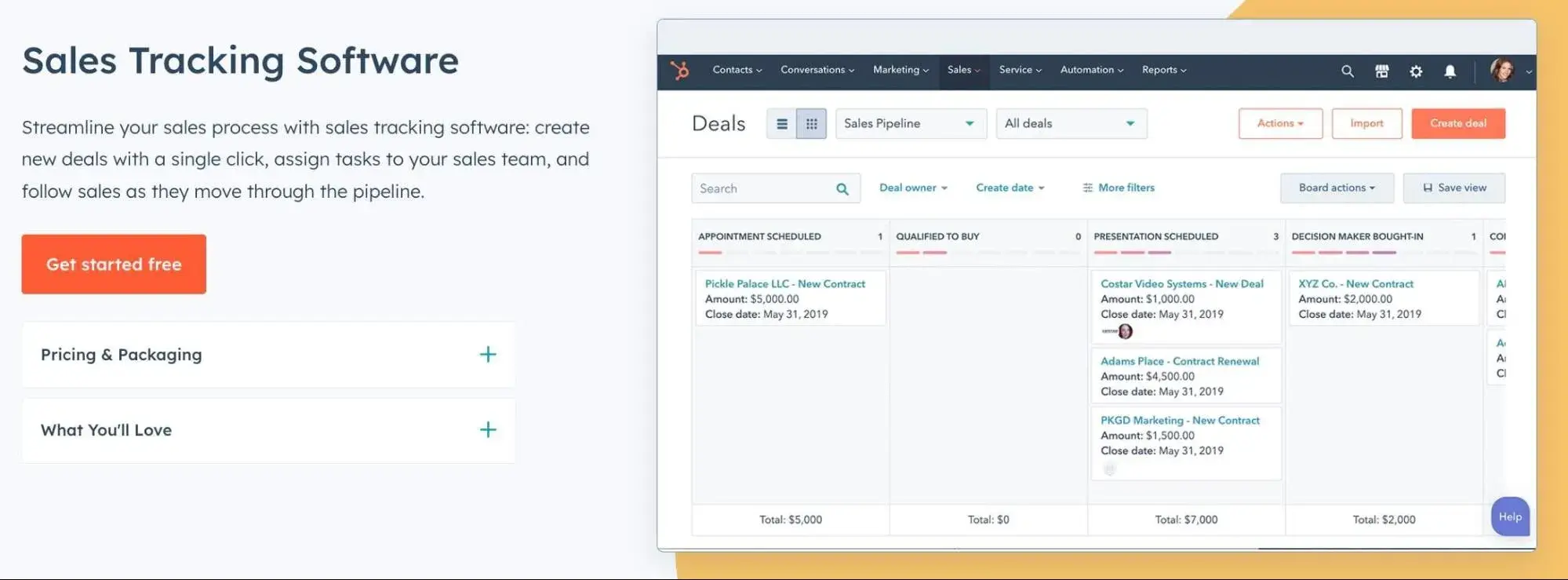
Why I like it for sales activity management: HubSpot’s Sales Tracking Software gives you complete visibility into your pipeline to help you understand performance, and custom reports make tracking rep activity straightforward.
Key Features
- Reporting dashboard gives visibility into rep activities and tasks
- Easily measure team performance against goals
- Pipeline performance reports to quickly identify bottlenecks within your cycle so you can implement further coaching
Free Trial: Free forever tools (max two users)
Price: Paid plans start at $20/mo/seat billed monthly or $15/mo/seat billed annually
2.Pipedrive
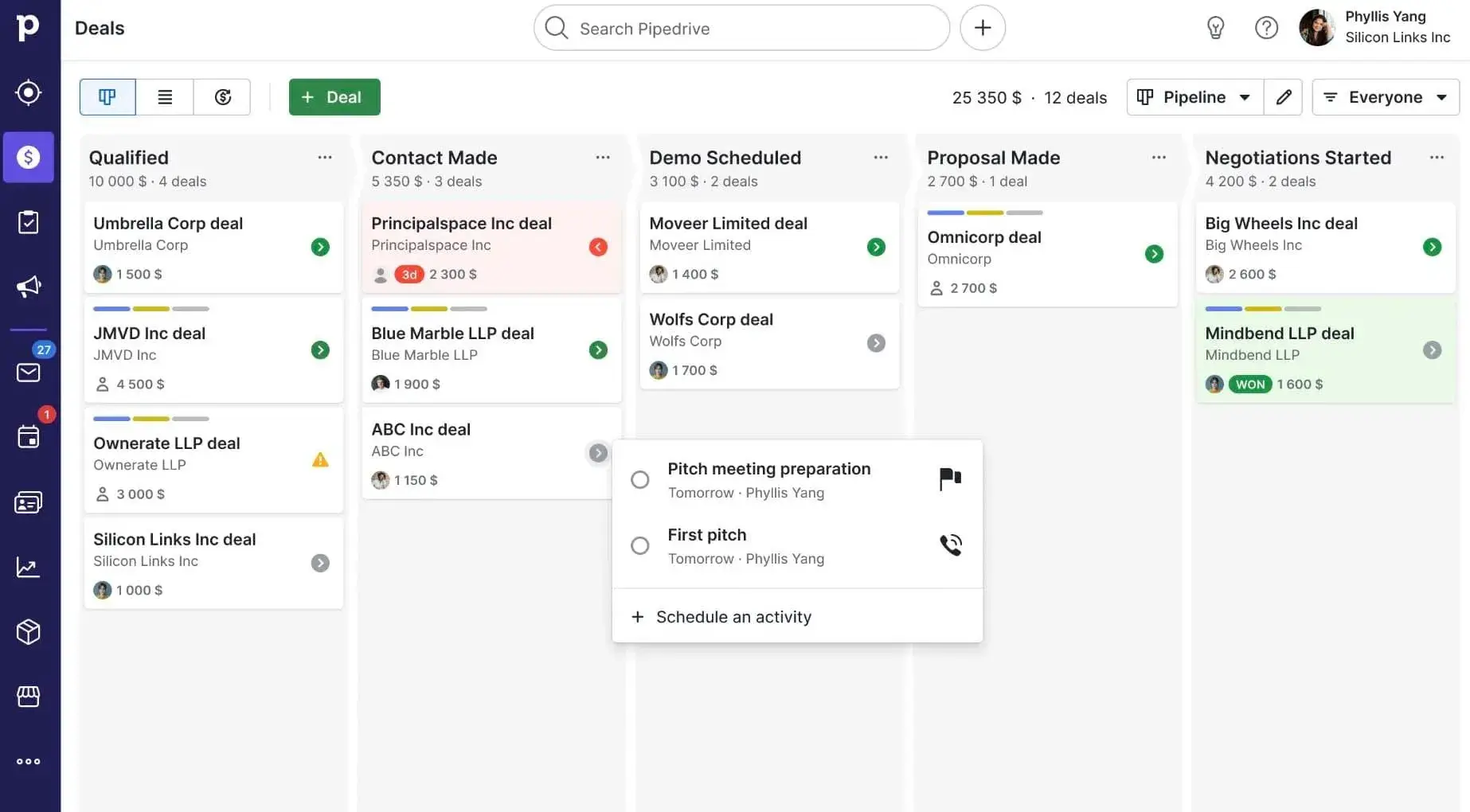
Why I like it for sales activity management: Pipedrive’s Sales Dashboard gives you insight into rep performance, making it easy to analyze critical activities and identify wins in a no-frills pipeline management dashboard.
Key Features
- Dashboard to track team activities (calls made, emails sent, etc.) in real-time
- Customize reports to the key activity metrics that matter most for your reporting (i.e., new deals, number of activities completed)
- Measure activities against goals to quickly identify coaching opportunities
Free Trial: Yes
Price: Paid plans start at $24/mo/seat billed monthly or $14/mo/seat billed annually
3.Salesforce
Why I like it for sales activity management: Salesforce’s robust customization options let you create a reporting and activity tracking dashboard that aligns with your team's needs.
Key Features
- Advance customization options make tracking pipeline activities that matter most for your goals easy
- Show reps key insights deal insights to help them plan accordingly and move the process forward
- Weekly pipeline change signals help you spot risks early to provide coaching
Free Trial: Yes
Price: Plans with tracking and management capabilities start at $100/mo/user billed annually
4.Monday.com
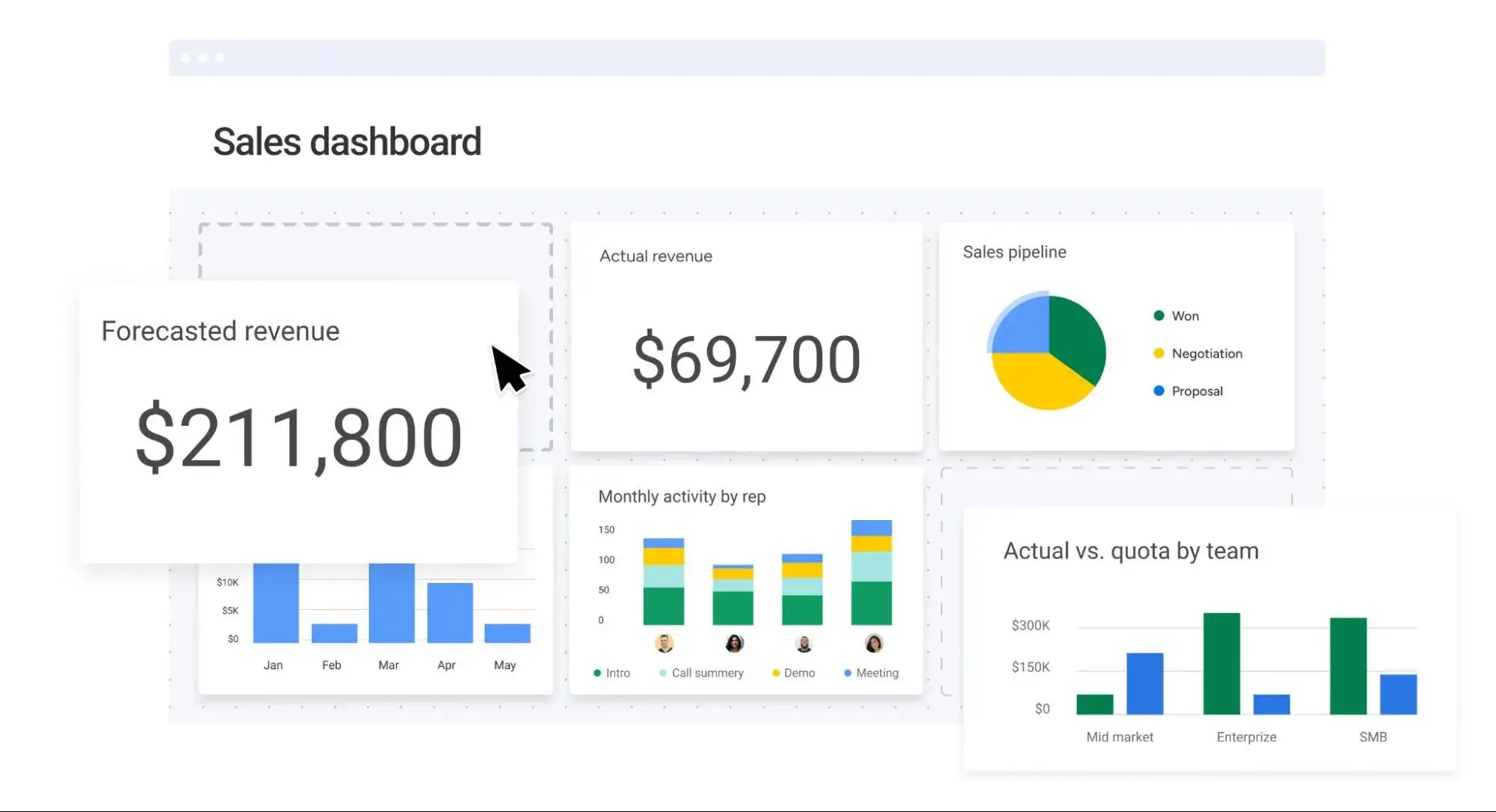
Why I like it for sales activity management: Monday.com’s intuitive and customizable CRM makes it easy to track sales activities to stay on top of performance; no technical expertise required to set up or maintain.
Key Features
- Activity and performance tracking dashboard updates activities and deal progress in real-time
- Visual progress indicators make it easy to spot potential issues and provide guidance to reps before deals are impacted
- Team goal monitoring can help you set healthy competition among reps
Free Trial: Free forever plan (max two seats)
Price: Paid plans starting at three seats max start at $12/mo/seat billed annually
5.Nutshell

Why I like it for sales activity management: Nutshell comes loaded with valuable sales reporting features for intuitive activity management and no steep learning curve.
Key Features
- Built-in reports help you see how reps spend their days
- Activity outcome reports show what actions have the most impact on won leads and closed deals
- Performance trend visualizations and loss reports help you spot what works and keep reps on track
Free Trial: Yes
Price: Paid plans with activity tracking begin at $32/mo/user per billed monthly or $25/mo/user(billed monthly
6.Copper
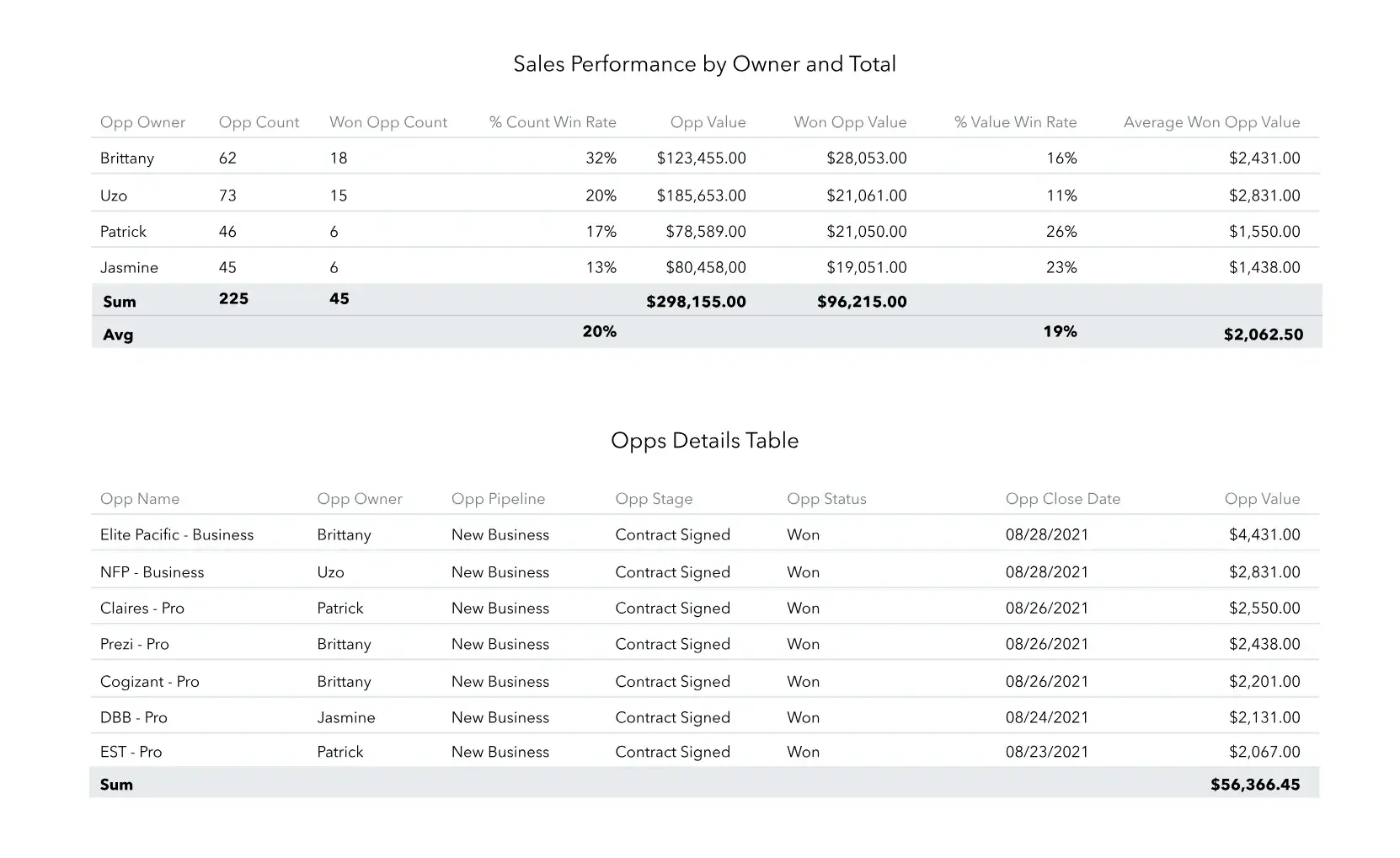
Why I like it for sales activity management: Copper, a CRM designed for Google Workspace users, automatically captures lead data and sales activities and synthesizes them into easily digestible dashboards for monitoring performance.
Key Features
- Real-time activity feed gives insight into what’s going on with all contacts and accounts
- Customized reporting tools allow you to build a visual of your pipeline to see how deals progress
- Sales activity-based leaderboard can help you spark healthy and motivational competition among your team
Free Trial: Yes
Price: Paid plans start at $12/mo/seat billed monthly or $9/mo/seat billed annually
7.Close
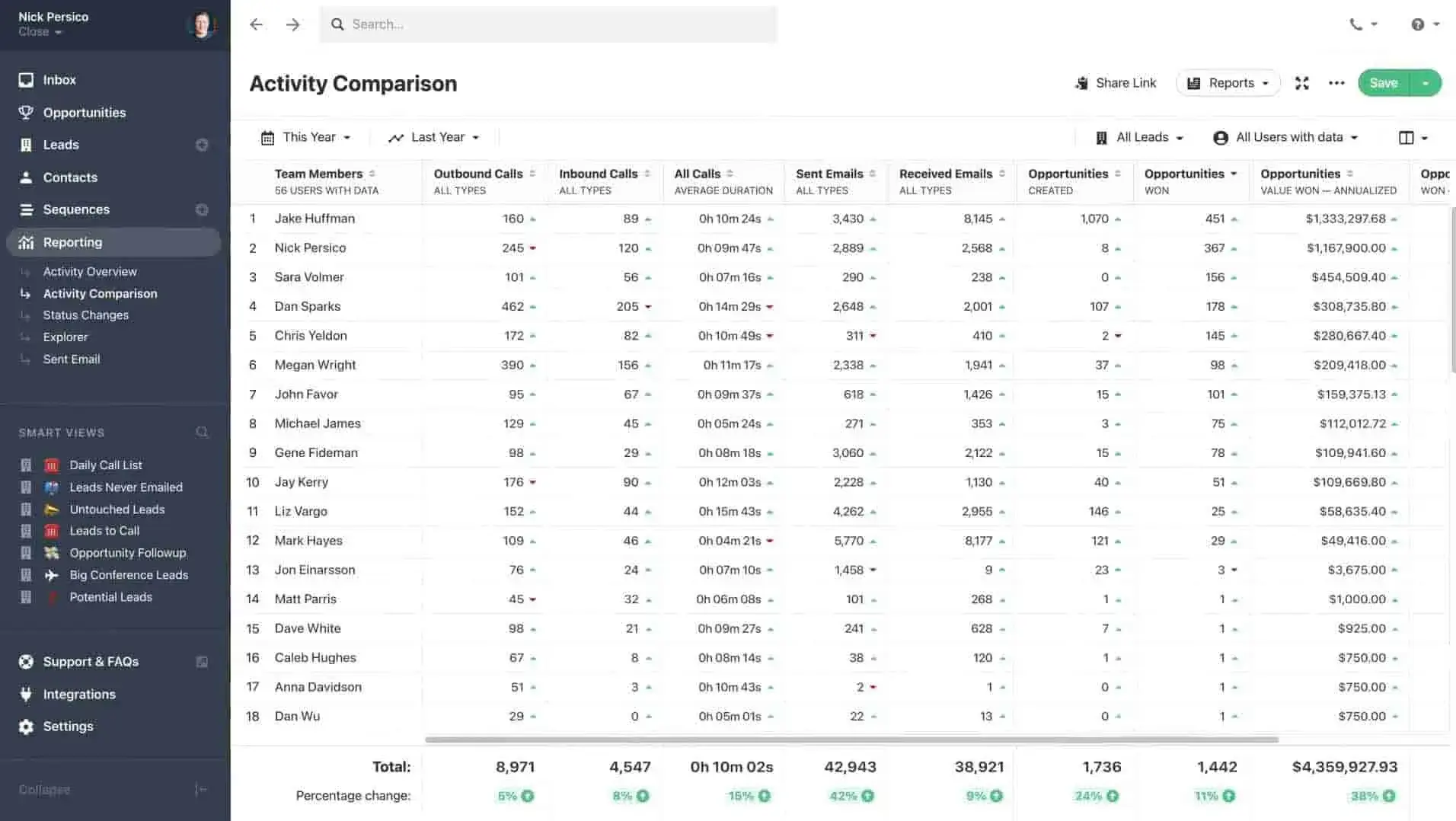
Why I like it for sales activity management: Close automatically logs sales activities and turns them into easy-to-read reports to help you focus on encouraging behaviors that move the needle.
Key Features
- Activity overview report gives you a holistic view of team or individual rep progress
- Opportunity funnel reporting to track sales velocity and quickly identify coaching opportunities
- Sales leaderboard to inspire and motivate reps
Free Trial: Yes
Price: Paid plans start at $29/mo/seat billed monthly or $19/mo/seat billed annually
8.Ambition
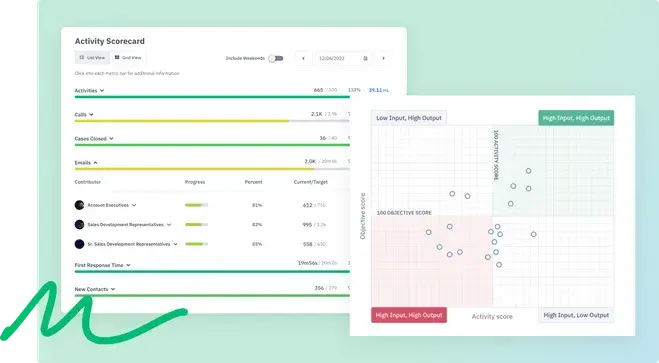
Why I like it for sales activity management: Ambition is poised towards sales management, with powerful tools for tracking, coaching, and gamifying sales activities.
Key Features
- Real-time activity and performance visibility show team progress-to-goals
- Create activity scorecards to help reps understand target metrics and link them to monthly objectives
- Leaderboards, competition, and performance recognition to gamify and inspire your team
Free Trial: Demo available
Price: Contact for pricing
9.Freshsales (by Freshworks)
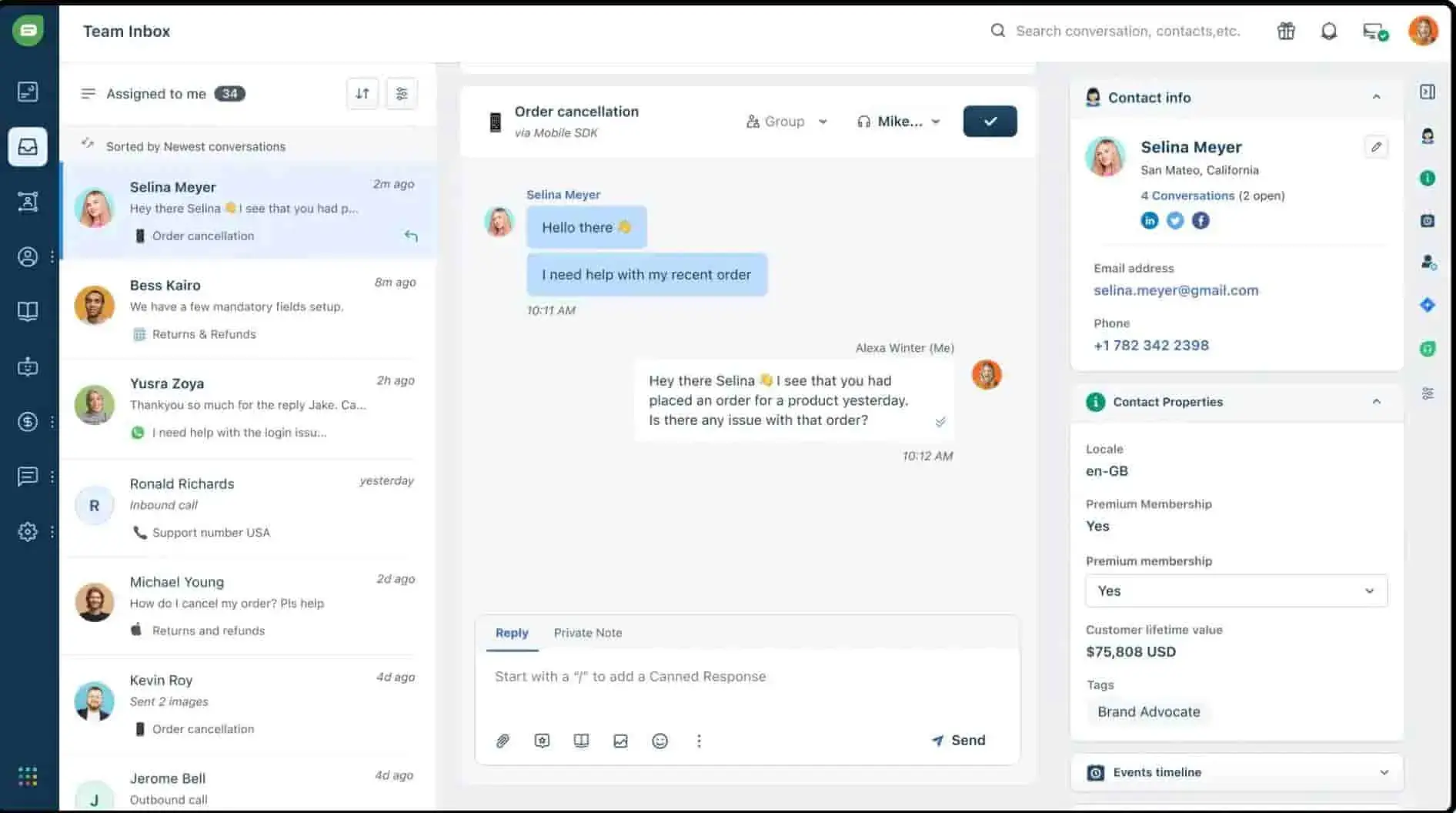
Why I like it for sales activity management: Freshsales is an easy-to-use CRM for tracking sales activity and managing contacts and deals to keep your team on track.
Key Features
- Custom reporting to track sales activities and pinpoint what brings in conversions
- Multi-channel activity tracking to monitor activities in a unified dashboard
- Platform intelligence analyzes activities, historical data, and offers recommendations to help you accelerate the sales cycle
Free Trial: Yes
Price: Paid plans start at $11/mo/user billed monthly or $9/mo/user billed annually
10.Agile CRM
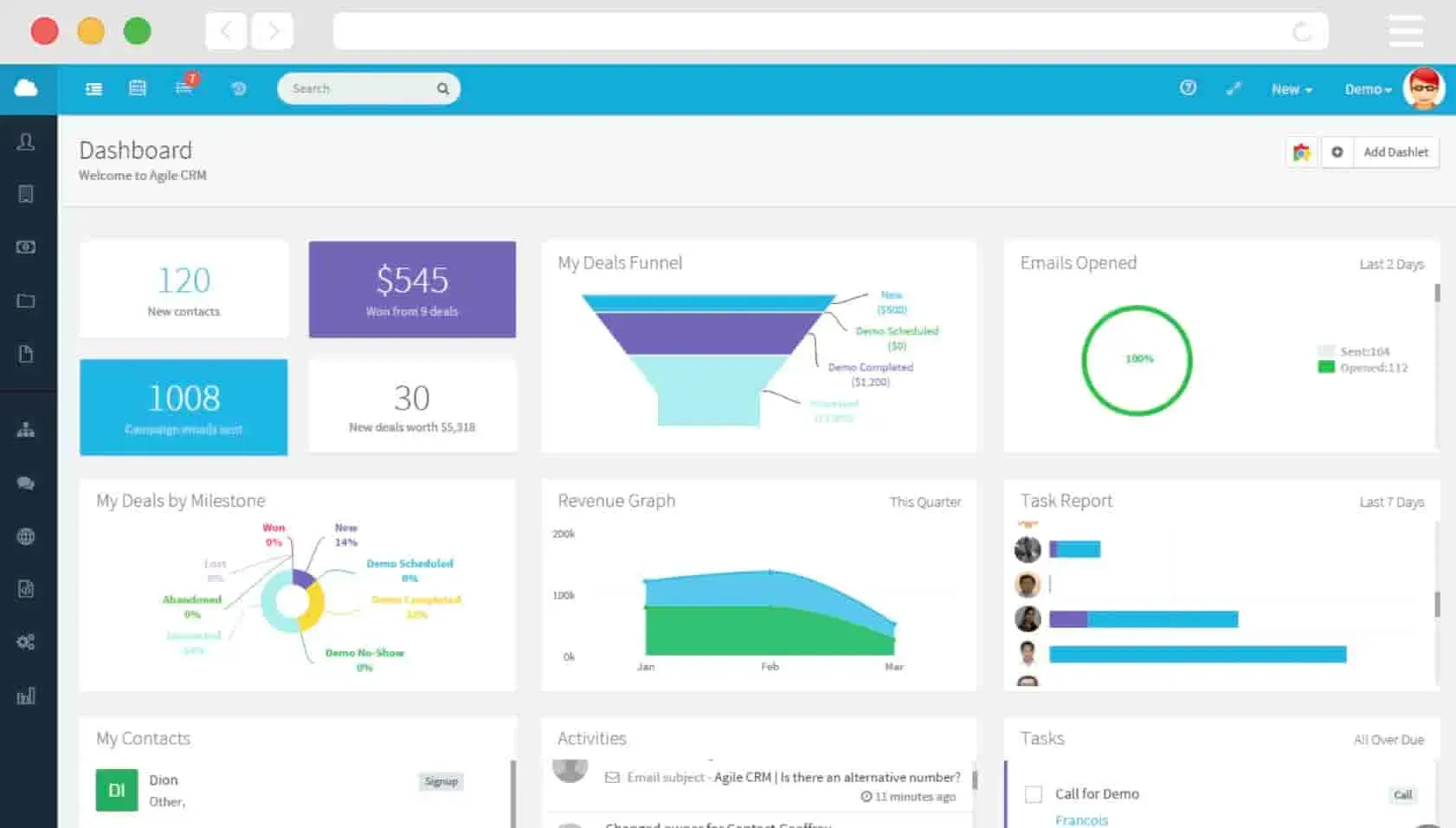
Why I like it for sales activity management: Agile CRM offers powerful reporting features to manage rep activity across channels (social media, email, etc.) and gamification options to encourage reps to reach activity-related goals.
Key Features
- Reports that give a view of pipeline health and how reps are performing against activity goals
- Pipeline management tracking to monitor stages and deal milestones to keep the sales process on track
- Gamification options for team motivation
Free Trial: Free forever plan (max ten users)
Price: Paid plans start at $14.99/mo/user billed monthly or $9.99/mo/user billed annually
Managing Sales Activities
Sales activity management can help you identify best practices and amplify what works across your team. Start by using software to keep track of crucial metrics. From there, you can turn what’s working into scalable processes.
info found here at bottom https://www.pipedrive.com/en/features/sales-dashboard
Editor's note: This post was originally published in March 2025 and has been updated for comprehensiveness.
Sales Activity Tracking


